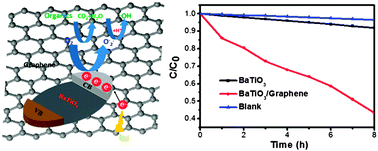BaTiO3 is a large band gap semiconductor, which only absorbs UV light in the solar spectrum. In this study, a series of BaTiO3–graphene nanocomposites with different weight addition ratios of graphene oxide (GO) have been synthesized by a facile one-pot hydrothermal approach, during which the reduced graphene oxide and the intimate interfacial contact between BaTiO3 nanoparticles and the graphene nanosheets were obtained. The as-prepared samples were characterized by transmission electron microscopy (TEM), high-resolution transmission electron microscopy (HRTEM), X-ray diffraction (XRD), ultraviolet-visible (UV-vis) diffuse reflectance spectroscopy, X-ray photoelectron spectroscopy (XPS), and Fourier transformed infrared (FTIR) spectroscopy. The photocatalytic activity of the obtained BaTiO3–graphene composites for the degradation of methylene blue (MB) under visible light irradiation at λ ≥ 400 nm was investigated, and a higher photocatalytic activity than that of pure BaTiO3 was observed. According to the experimental results, we suggest a new photocatalytic mechanism, in which the role of graphene in the BaTiO3–graphene nanocomposites is to act as an organic dye-like photosensitizer for large band gap BaTiO3. The photosensitization process of BaTiO3 by graphene transforms the wide band gap BaTiO3 semiconductor into visible light photoactivity in dye degradation. This reaction mechanism could widen the applications of BaTiO3–graphene nanocomposites in solar energy conversion, promoting our thinking on the microscopic charge carrier transfer pathway connected to the interface between the graphene and the semiconductor.

